Just building a great app is not enough. You must also optimize it for app stores so that it reaches the maximum audience. Read on to learn what is App Store Optimization and how to leverage it to get more downloads on your app.
According to a Statista report, there are 3.48 million apps on the Google Play Store and 2.11 million apps on the Apple App store as of the first quarter of 2021. Volumes like these make it hard for existing apps and new ones to be found or discovered by mobile phone users.
This is where App Store Optimization (ASO) kicks in. It helps app publishers and makers promote their mobile apps better. ASO ensures that the app gets ranked and matches the user search intent.
So, what is ASO, how does app Optimization work, and how can you win the ASO game? Read on to find answers to your questions in this ultimate App Store Optimization guide.
What is App Store Optimization (ASO)?
If you are an app developer or owner, there are only two ways to present your app in front of your potential users – advertising and built-in or organic searches on all app stores. While you shouldn’t miss out on any mode that drives your app’s desired visibility, investing in improving the organic app ranking will prove more valuable in the long run.
Organic searching is based on the user’s true search intent to serve a specific need, which isn’t the case when you invest in paid advertising and then get downloads for your app.
Therefore, to increase your app’s reach while enhancing its findability and discoverability, include ASO in your mobile app development checklist.
How Important is App Store Optimization (ASO)?
Mobile Apps are a huge business opportunity. And with tens of millions of apps available for download across all app stores, it is hard for businesses to make their app stand out in the crowd.
To summarize, here are three reasons why ASO matters:
1. App Stores are the Largest Discovery Channels for Apps
According to a Google report, 40% of smartphone users browse for apps in app stores. That means searching is the primary source of app discovery, and App Store Search Optimization is something that can help you nail it.
App optimization’s ultimate goal is to let the users discover, click, and download your app from the app stores. It focuses on improving the app’s visibility and conversion rate optimization, leading to more app downloads, fewer overheads, and higher revenues.
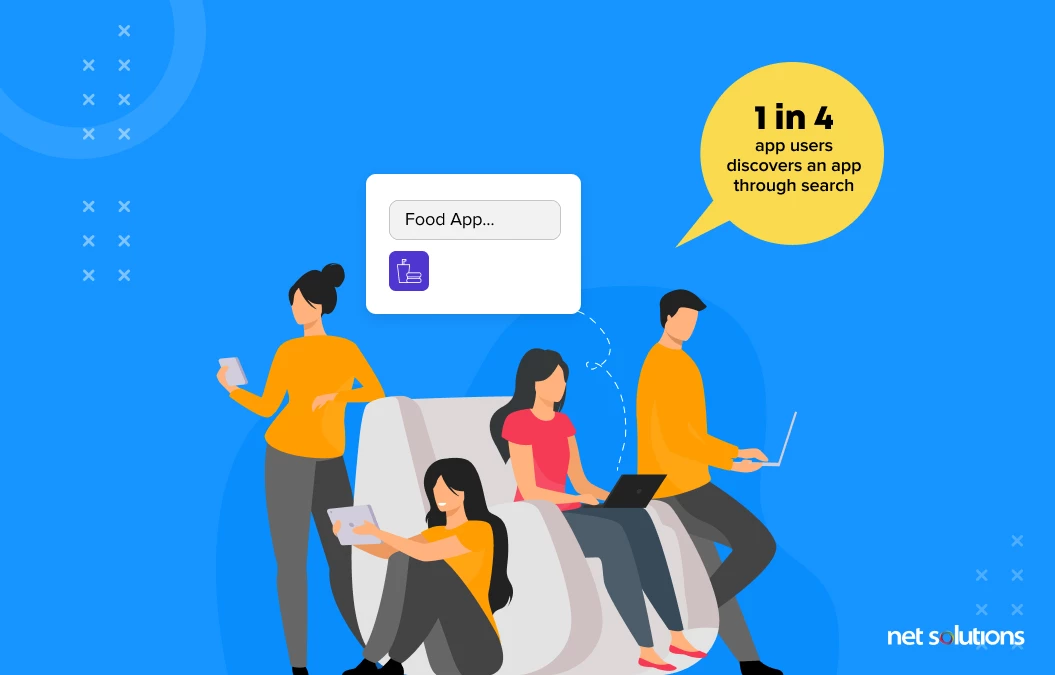
2. Organic Downloads = Lower User Acquisition Costs
In the end, the business bottom line makes a difference, and the app biz is no exception. If you have a good ASO strategy in place, your organic app downloads will increase over time, with a solid return on the initial investment.
Once you are done with implementing proper and advanced App Store Optimization strategies for your app, it will start ranking higher in the app search results and will drive your revenue, while keeping the costs down.
3. App Store Optimization is a Long Term Fix
If you are a startup, throwing your entire marketing budget into paid ads may drive you a bunch of new users, but it isn’t a long-term fix. Once the downloads slow down, you’ll again have to pour money into in-app advertising, which is not at all a profitable option. However, ASO is a one-time investment and, with a winning approach to it, you can keep those app downloads coming in regularly over time — which is one of the most important app store search optimization benefits.
How to Optimize Your App for the App Store?
Just like search engines, mobile app stores also use intelligent algorithms to rank apps. If you want your app to nail these algorithms and rank at the top of app store searches, you must be willing to do the hard work and optimize your app for the app store.
Here are some of the best App Store Optimization strategies that can help you en route:
1. Do a User-Oriented Keyword Research
Keywords are the main ingredient in marketing. Since ASO and marketing are intertwined, keywords play a crucial role here as well. Therefore, the first of many App Store Optimization steps is to conduct in-depth research on your target market, users, and competitors.
Find out their desires, needs, and what language they use when looking for a solution that your app provides. Knowing your target market in and out will help you win the ASO game.
The goal here is to make a keyword list that you can use while defining your app in the app store listing. Though it is not a very tedious task, it requires your focus, time, and some useful resources – here are some of them to make your keyword research for app store listing optimization easy:
A. Searches in the App Store
Whether you are planning to launch your app on the Apple Store or the Google Play Store, you can use a keyword that you already know suits your app to find new variations and different keywords related to the same. This is carried out by autofill like the features of the App Store itself.
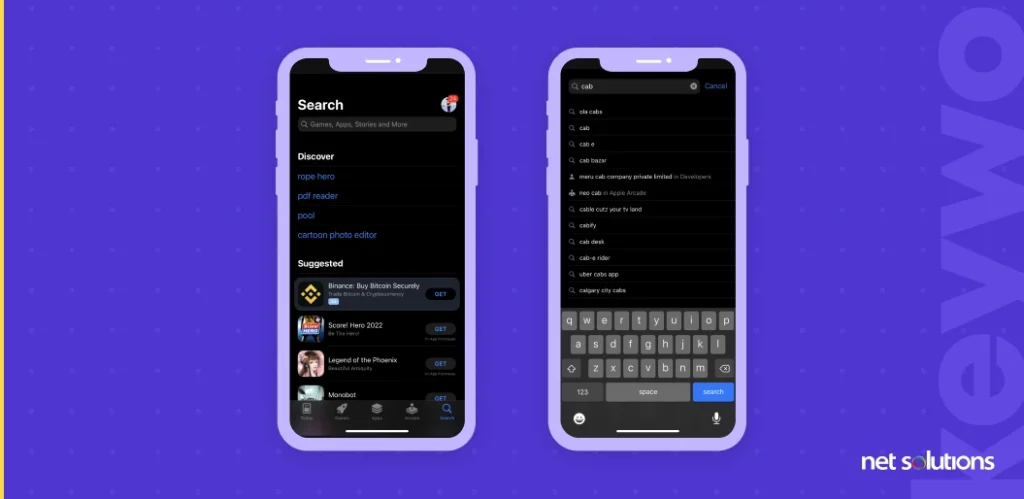
While you look for these keywords, make sure that the keywords you find:
- Describe the main feature of your app
- Define your app’s category
- Are popular among your users
- Have high searches and less number of apps
Remember that you may come across many irrelevant autofill keywords while doing so, and you need to put your own thoughts into finding what suits your app and what doesn’t.
B. Users Reviews
You can also find some useful phrases for App Store keyword optimization in the user reviews of your competitor’s applications. It will help you learn how you can describe your app in the most appropriate terms for your users.
There are several App Store Optimization tools available online that can help you analyze these reviews for the most popular keywords and searches. App Annie lets you see around 200 app reviews per page, and you can also filter these for many dimensions like ratings, country, and version.
When searching for reviews on iTunes, you can see votes on each review to find which one connects with the most people. The app store keywords you will find this way will be the ones that will help you connect with your potential app users easily.
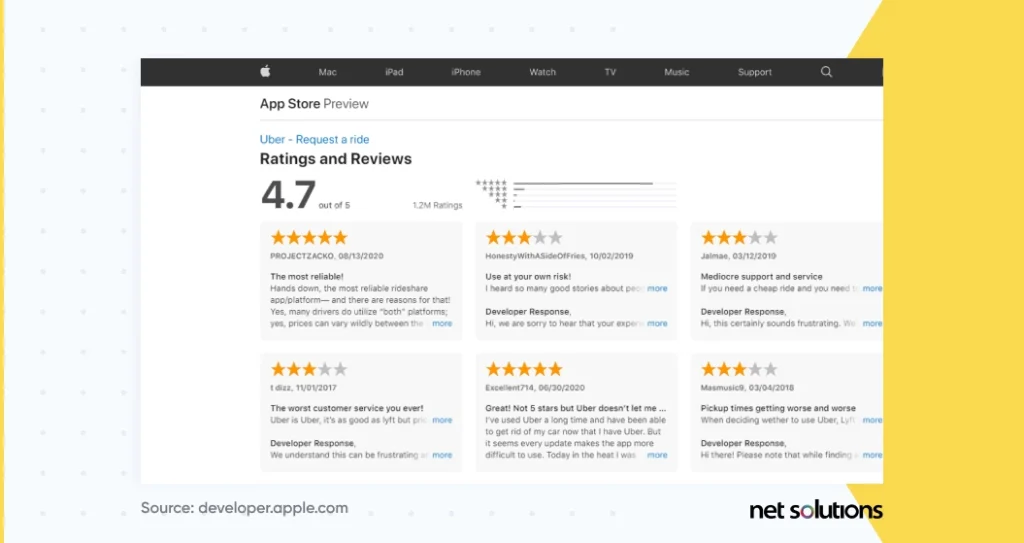
Along with these, you can also use Apple search ads, Google AdWords, or competitor apps to search and find relevant keywords for your app. While all these are manual methods of finding the suitable App Store Listing Optimization keywords, let’s now talk about some automated solutions.
C. App Store Optimization Tools
Just like SEO, ASO also has some tools that can help you in increasing your app store visibility. These tools help you find relevant app store keywords from all the manual channels and centralize them in one place for you to analyze and select. Although most of these app optimization tools will cost you around $50, you can track 100s of keywords easily and efficiently.
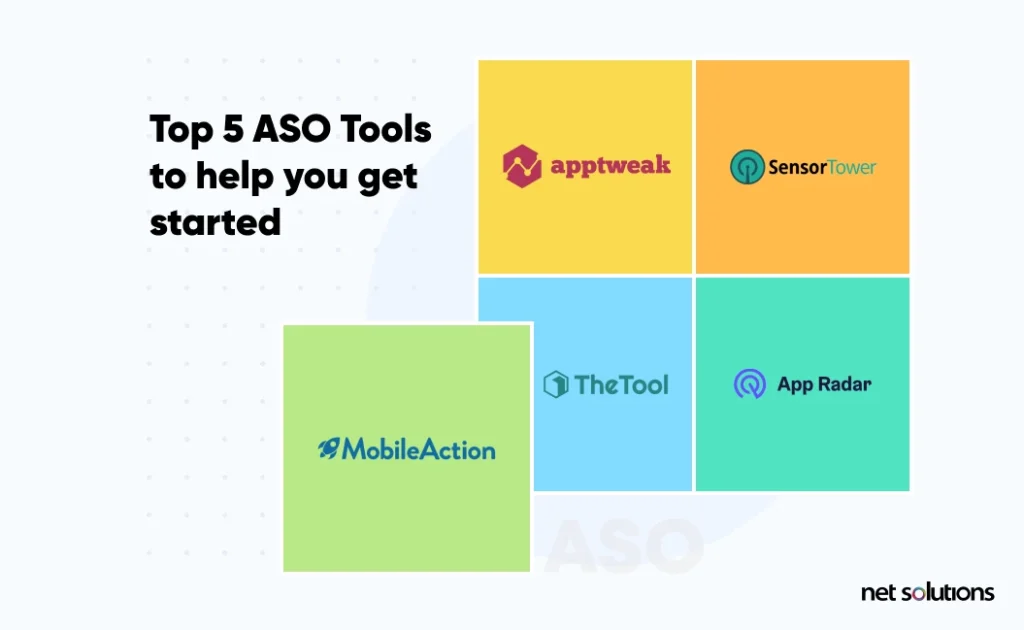
All these ASO tools are great for not just discovering new keywords but for tracking keyword performance as well.
2. Use Keywords Wisely
Once you have done all the heavy lifting for finding the right keywords to use, the next step in our App Store Optimization checklist is to sprinkle them the right way in the app listing. While Google Play doesn’t have a separate section for inputting app store keywords, Apple allows up to 100 characters to add the main keywords you want to target.
With that said, the app description in Google Play Store is searchable. You can put your most important keywords in the description of the app while making it more precise.
Also, keep in mind to:
- Separate words with commas
- Use singular versions of the noun to save space
- Not to use long-tail phrases
- Not to repeat the keywords that are already in the title
Along with the description, you also have to use them in your app’s title very carefully to ensure it is related to users’ searches. Before you publish your app, it is also crucial to check your app store’s rules and guidelines to avoid any surprises later on.
For example, Apple wants you to avoid any special characters – such as @, $, or # – in keywords unless they are a part of your brand identity. So, pay special attention, as not adhering to these rules may lead your app to be rejected by app stores.
3. Choose the Right Name for Your App
This is the first and most important step in the mobile application development process. Your users will remember your mobile app or game by a certain name. So, make sure you nail its creation with the right math.
All in all, your app title should be:
- Easy to remember
- Descriptive
- Contain one or two keywords
- No more than 25 characters long for Apple App Store
- No more than 45 characters long for Google Play Store
We know the task of creating such a title is difficult. Let’s have a look at popular apps with creative app names for inspiration.
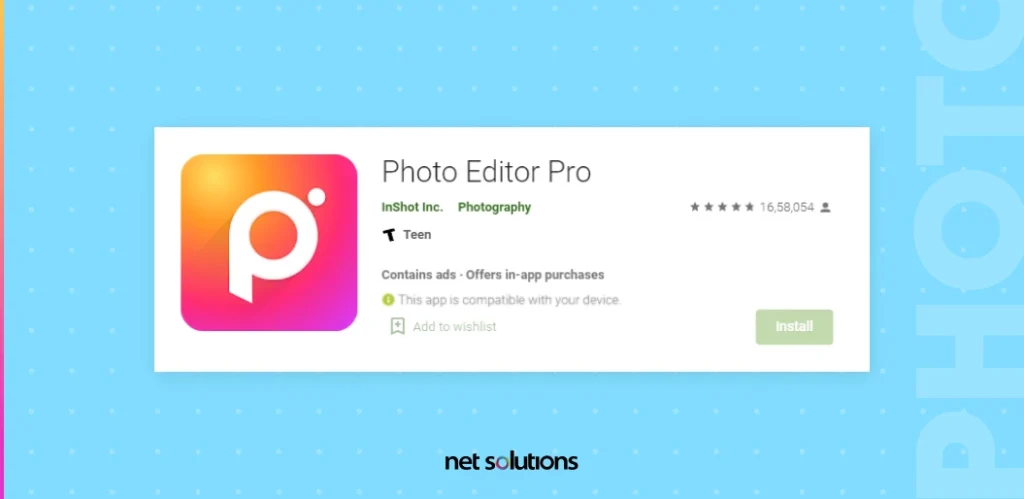
Now that’s what a perfect app name should look like. It is easy to remember, short, keyword-rich, and descriptive – all in one. The name perfectly fits the display space, and by adding “Pro” at the end, the app has done its job right to stand out in the market. After just looking at this name, users can easily predict what the app is about and how it can help.
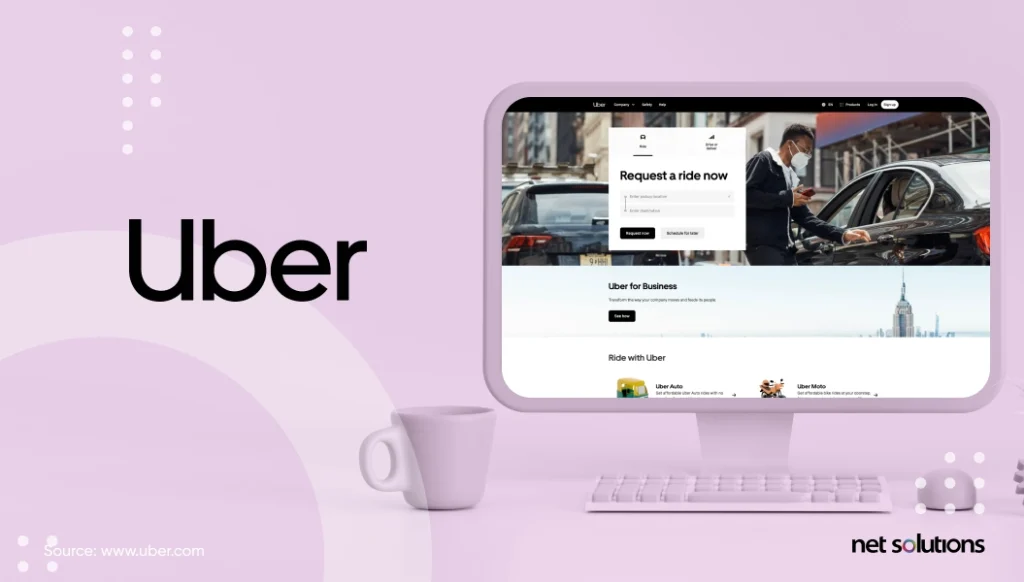
Another example is Uber. Here the case is a bit different. The brand name alone doesn’t define what the app is about. However, the keywords added next to it performs the job well. “Easy Affordable Trips” describes the problem it solves.
This is an example for those who already have an app name in mind that doesn’t describe the app functions well. Just add a few keywords after the name, and it will help improve your app rank in app stores, and users will also find it relevant.
Here’s what adding keywords in the app title can do to the app rankings.
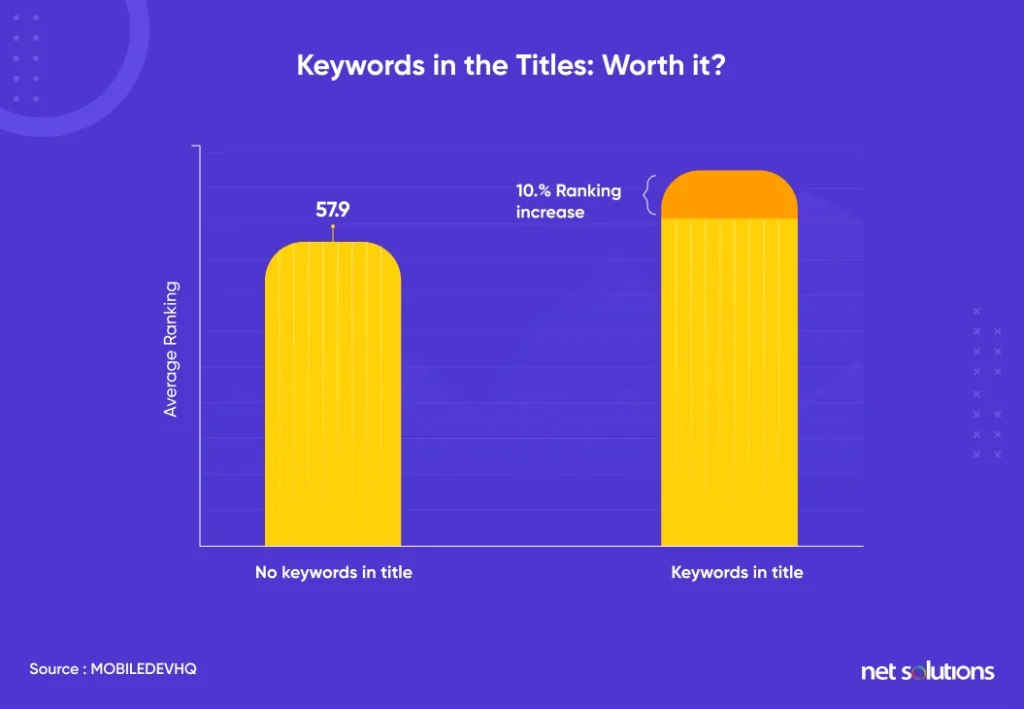
4. Create Accurate App Descriptions
After the title, the app description is an essential part of an app’s metadata as it helps users find the information about your mobile app’s features and functionalities. Therefore, your app’s description should:
- Be informative and easy to understand
- Include your important keywords
- Mention what problem it solves and how it’s solved
In short, your app’s description is your chance to put your app idea into words, and you have to do it very carefully. Also, the Google Play Store and Apple App Store both have different rules and guidelines for adding app descriptions.
For Google Play Store optimization, you will have a short field of up to 80 characters and a long field of up to 4000 characters to describe your app. It also indexes content in both these fields to rank applications, and you can rank higher by repeating your essential keywords up to 5 times in these two fields.
However, while working on Apple App Store optimization, repeating keywords in the app description or title is a waste of space, and it also doesn’t index this content. However, it doesn’t mean you should ignore keywords in the App Store. Try to explain what makes your app unique by using the right set of keywords and also use a strong call to action that compels your users to download the app.
5. Optimize Your App’s Icon
Humans have a remarkable ability to remember pictures
– PNAS
And that’s why you have to focus on image-based App Store Optimization for getting desired app rankings and downloads.
If you don’t know what an ideal app icon should look like, take a look at the App Stores. Your eyes will naturally scroll to the icons with an amazing look and feel, elegant shapes, and perfectly blended colors. Here are a few tips on what your app’s icon should look like:
A. Let Things Come Naturally
While creating an app’s icon, you shouldn’t forcefully add your company’s logo or name to it, especially if it is a long name. It makes an awful impact on app users and is not at all easy on the eyes.
B. Keep Everything Simple
Your app’s image size and quality need to be optimized, and your app’s icon should also reflect the core idea of the app. For example, this Weather App’s icon alone explains all the functions of this app.
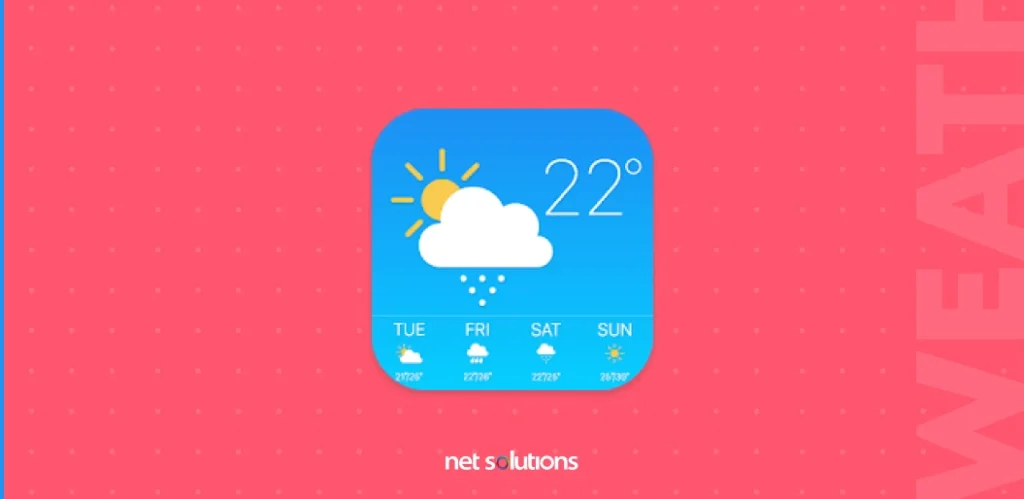
C. Be Consistent
The ultimate goal of designing an attractive icon is to build your brand identity. If your design doesn’t have longevity and you keep changing the app’s icon too often, you will lose consistency.
6. Add Videos and Screenshots
Adding compelling visuals can help your app stand out in crowded app marketplaces. So why miss any chance?
Regarding your icon, the app’s screenshots and a demo video can help you attract users to it, which will influence its number of downloads. These visuals will help users predict your app’s experience and functions.
For example, Grammarly shows the app’s functions and the value it will provide to its users in just four images.
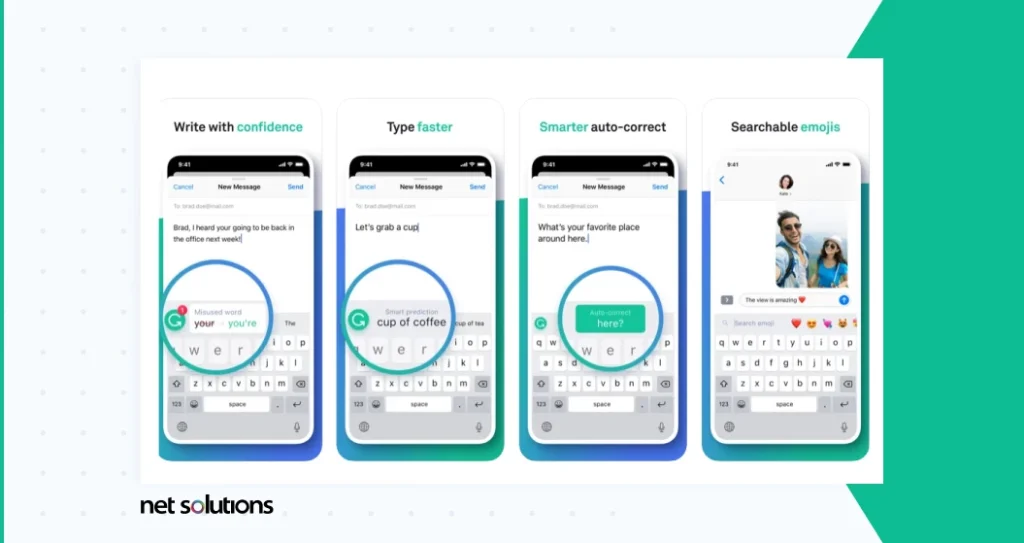
You should consider your app’s screenshots as promotional graphic content to show your users how your app will add value to their lives. This type of content serves users who like to know about the app but don’t want to read the long app descriptions.
Along with screenshots, you can also use video to attract users. According to research, 78% of people say that they were convinced to buy or download a software or app by watching a video. Therefore, adding a video can engage your users on the App Store page, and chances are high they will end up downloading your app.
For example, If you plan to do App Store Optimization for games, you can add a short video in your app listing that shows users how to play it.
App previews in Apple App Store let you upload a 30-second long video to show users the benefits your app provides. But, to use them to your advantage, you will have to make sure that your mobile app UX looks amazing and that the video reflects the in-app experience that your prospective users are looking for.
7. Encourage Positive Reviews and Ratings
Though you do not have 100% control over your app’s rating and reviews, you must attempt all you can to improve it.
The third-party App Store Optimization factors like ratings, downloads, and reviews of your app play a big role in improving your app store ranking and overall image of your brand. Your app should have happy, authentic, and well-written reviews that explain why your app is useful and how it adds value to its users’ lives.
But, make sure that all these reviews are honest ones coming from users who actually used your app. Here are some ways to get those much-desired reviews for your mobile game or application:
- Encourage users through word of mouth to leave a useful review
- Send your users a push notification asking them to leave a review for your app
- Add an in-app pop-up asking users for a review when they open your app or are about to complete an action
Besides app reviews, app ratings are also an important factor that improves the app ranking. The higher the average star rating your mobile app has, the higher it will rank in the app stores.
Google Play Store even indexes the keywords your app users use in reviews to rank the app. This is the reason it becomes even more important to ask your users to rate and review your app.
Apple even has an API for app developers to help them increase app ratings. Apple allows you to use this trigger up to three times a year to get meaningful reviews for your app.
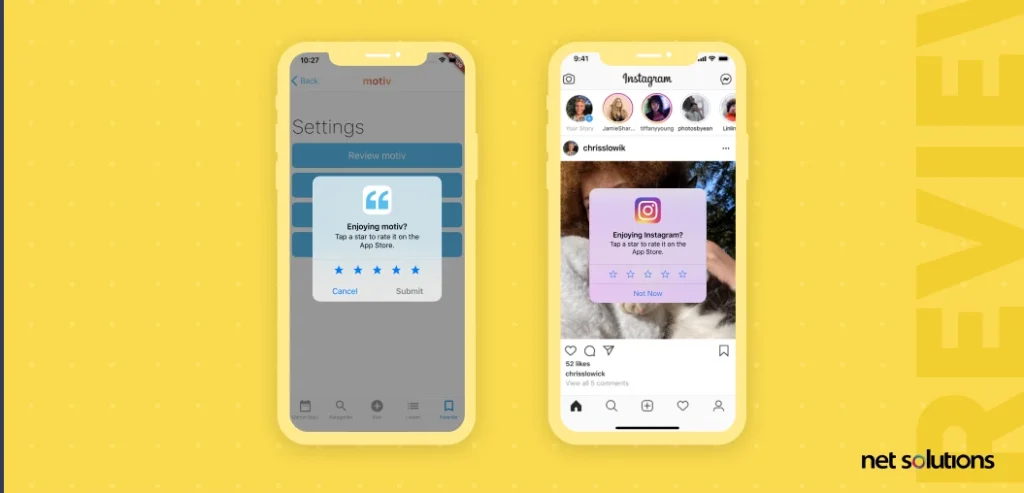
Remember, asking for ratings and reviews over and over again may ruin your app’s experience, and users might end up giving a one-star review of your app just because they got so many pop-ups asking them for reviews and ratings. So, don’t push your users over the edge to get reviews, or you might ruin your ASO game.
Frequently Asked Questions
1. Is ASO a part of SEO?
No, ASO and SEO are two entirely different concepts. SEO is about optimizing a website so that it ranks higher in search engines. On the other hand, ASO is optimizing your app in such a way that it ranks higher in an app store. Hence, the results you will get in both approaches are different.
2. How can I see my app ranking in Play Store?
You can use the Rank Tracker Dashboard report to see Google Play rankings for your app URL or even your competitors’ URLs. The dashboard also has options like keyword metrics, backlinks, rank change filters, and landing page metrics.
3. How does the App Store algorithm work?
When a user searches for a keyword in the app store, its search engine displays the related apps to it. Hence, if you add a lot of relevant keywords to your app’s description, it will be displayed to a lot of people.
SHARE THIS POST
Table of Contents
Related Resources
- The Mobile App Architecture Guide for 2024
- 7-Step Mobile App Development Checklist (Free Download)
- How Much Does it Cost to Build an App [A Complete Breakdown]
- How To Protect Data In Mobile & Web Apps Using Encryption
- eCommerce Mobile App Development: A Step-by-Step Guide
- 7-Step Mobile App Development Checklist (Free Download)
- How Firebase is Emerging as an Innovation in App Development
- A Complete Guide to Implementing In-App Purchases
- Low-Cost Mobile App Development: A Comprehensive Guide
- How to Make an App in 2024: 5 Stages of Mobile App Development
- What is Mobile-first Design (+9 Best Practices)
- The Ultimate Guide for New App Ideas
- Offshore Mobile App Development: An In-Depth Guide
- Most Popular Programming Languages for Mobile App Development
- 7 Mobile App Development Tips for Acquisition & Retention
- Top 15 Mobile App Development Trends to Watch for in 2024
- The Fundamentals of Android App Development: Basic Tutorial



